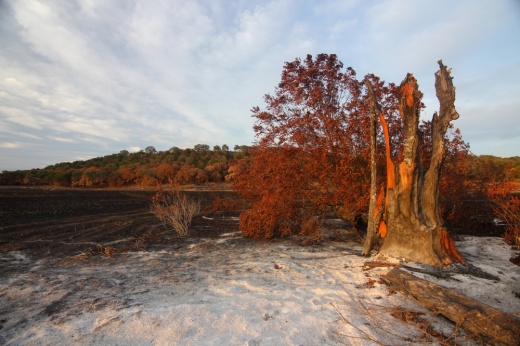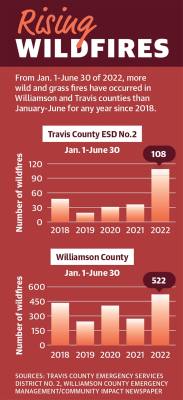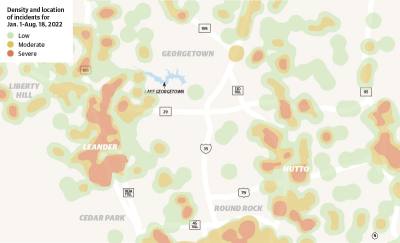This fire season is headlined by the San Gabriel Fire that burned about 450 acres in late July just north of Leander.
Figures from Travis County• Emergency Services District No. 2 and Williamson County Emergency Management show 630 wild and grass fires occurred within the first six months this year.
The last time those numbers were close to that figure was in 2018, when both jurisdictions combined saw 484 wild and grass fires.
As record heat and months •of dry conditions persist, area •firefighters and weather and climate experts maintain the situation could get worse.
“Everyone at every level is trying to do what they can to prepare for the next [fire], and it’s not going to stop until we get some rain and until the temperatures change,” said James Mallinger, Cedar Park Fire Department chief.
Wildfires spike locally
Shane Glaiser, Round Rock Fire Department chief, said in his jurisdiction, it only took six weeks, from the beginning of July to mid-August, for the number of wild and grass fires to nearly double from 68 to 111.
Glaiser said the higher number calls his department has responded to correlates with population growth.
“You have more people, and so you have more chances for an accident,” he said.
Local fire chiefs said small grass fires are the most prevalent.
In Cedar Park, Mallinger said while the department has responded to 34 local fires in the first six months of 2022—more than any other first half of the year in the last five years—there has only been one large incident, a 15-acre fire off East Whitestone Boulevard.
Similarly, data from the Georgetown Fire Department show it responded to 209 fires in the first seven months of this year, including 87 fires in July. This is about double the number of fires GFD responded to in any single year from 2018-2021.
Areas that are sparsely populated and less developed, such as unincorporated Williamson County and the outlying areas in Travis County ESD 2, are where fires are eating up more acreage, local chiefs said.
However, Georgetown Fire Department Chief John Sullivan said as more land is developed, fires have the potential to threaten more homes. The San Gabriel Fire, for example, threatened about 60 homes near Lake Georgetown, he said.
From January through July, Williamson County received 692 calls for “outside” and “vegetation” fires, surpassing the total number of calls in 2021 and 2019, and rivaling the number seen all year in 2020 and 2018—which had 761 and 736, respectively.
Despite this increase, Michael Shoe, Williamson County director of emergency management, said the county has been successful at quickly responding to fires, in large part due to state and national help.
Shoe said for the San Gabriel Fire, responders from nearly every state in the U.S. were at the scene.
“Normally we don’t have this, but because this year was supposed to be a real high fire danger for our state, they were all brought in here,” Shoe said.
Locally, most cities and counties sign mutual aid agreements with one another, and fire chiefs said they often help at fires outside their immediate jurisdiction.
“The reality is that it is very easy for an incident to exceed the capabilities of a local jurisdiction,” Sullivan said.
Travis County ESD 2 Chief Nicholas Perkins said the stark increase in incidents this year compared with other years is historic.
“We’re running, at least, a wildfire every day,” Perkins said. “This is ranging all the way from a grass fire on the side of the road all the way up to a multiacre grass fire potentially with some structures being threatened.”
Hot, dry conditions
John Nielsen-Gammon, Texas state climatologist and director for the Texas Center for Climate Studies at Texas A&M University, said it is not surprising the area north of Austin and beyond has experienced a busy fire season because the region is in the middle of an “intense drought.”
“We see a direct correlation in the number of wildfires we are responding to with this lack of precipitation and the high temperatures we’ve had this summer,” Mallinger said.
Rainfall is a key mitigating factor in helping to reduce wild and grass fires in a given area, according to Kari Hines, Texas A&M Forest Service Firewise coordinator. Hines said 2022 so far ranks among the worst for dry conditions and fire incidents in Texas in the last decade.
Data from the National Oceanic and Atmospheric Administration shows from January to July 2021, Williamson and Travis counties received about 23 inches of rainfall. For the same time period this year, rainfall in both counties totaled about 10.5 inches.
Leander Fire Department Chief Billy Wusterhausen said in these conditions it only takes a single spark, such as one from a discarded cigarette, broken bottle or dragging chain, to start a fire.
“The fuel is already there, and it’s dry and you’ve already got oxygen in the atmosphere, so all it’s looking for is that spark,” Wusterhausen said.
Although data collected at the Georgetown Municipal Airport show the area received more than four inches of rain in late August and early September, Nielsen-Gammon said the only way out of these conditions is consistent rain. While a little rain will make it temporarily harder for fires to start, it will take several inches of rain for grasses to come out of dormancy and become less flammable long term, he said.
“[We want] preferably several different rains because we don’t want it all running off—we want it to soak into the ground,” Nielsen-Gammon said.
Long-term preparation
Moving forward, local and state fire authorities expect to see more wild and grass fire incidents. Hines said wildfire windows are projected to expand over the next several years due to diminishing moisture levels combined with more heat.
“Land management and emergency response agencies are seeing and are forecasting an increased rate of days where we can have wildfires impacting our communities,” Hines said.
Some fire mitigation projects have occurred in Williamson County, including an effort this spring at Twin Springs Reserve near Lake Georgetown, according to county officials.
Local fire chiefs also stressed the importance of residents being cautious and aware of their surroundings so they do not spark a fire. This can range from not throwing cigarettes on the side of the road to adhering to the burn bans when they are in place in both Williamson and Travis counties.
Nielsen-Gammon said as temperatures continue to rise due to climate change, local weather will trend toward more hot and dry conditions.
“[Wild and grass fires] will still be confined to mostly dry years—so this won’t be something we expect to see every year—but we do expect them to become slightly worse overall,” Nielsen-Gammon said.










